History of the Library
The library was founded in 1899 with financial support from the Falls Church Village Improvement Society (VPIS), which amassed several hundred books for circulation to community subscribers from a structure behind the home of George W. Hawxhurst at the northeast corner of North Washington and East Columbia Streets. In 1913, the collection was transferred from VPIS to the Falls Church Civic League (known later as the Falls Church Woman's Club) and continued to operate out of different locations throughout Falls Church until the late 1950s.
The Town of Falls Church first officially began supporting the library in 1928 and assumed full responsibility for the library in 1940. After becoming an independent City in 1948, the City of Falls Church established a formal library board in 1954 and ultimately funded construction of a new library building on land donated by the children of Mary Riley Styles, the longtime chairwoman of the Library Committee of the Woman’s Club who passed away in 1946.
The new building opened in 1958 and has since been renovated and expanded three times: 1969, 1993, and most recently 2021. Previously known as the Falls Church Public Library, it was re-named the Mary Riley Styles Public Library in 1977.
Today, the library continues to serve the City of Falls Church’s roughly 15,000 residents, as well as library users throughout the Metro DC area.
1899 & 1900 - 1909
1899 -- The Falls Church Library is founded as a private subscription library with financial support from the Village Improvement Society. Many libraries in the United States were established by men’s clubs, but this society was not restricted by gender.
1900 – The library is housed in a small outbuilding on the property of Falls Church mayor George W. Hawxhurst. Hawxhurst acts as librarian with the assistance of his daughter, Nellie. The library is managed by a Library Association with a Board of Control.
1906 – Hawxhurst becomes the town postmaster and the library moves to the back of the Falls Church Post Office. This is the first of what will be many moves for the library.
1915 map showing proposed racially restricted zoning
1910 - 1919
1913 - A local women's organization, the Civic League, takes over library operations, working from an alcove in the former Congregational Church building at 222 North Washington Street.
1915 - Black leaders form the Colored Citizens Protective League and sue to prevent a racially restrictive zoning ordinance from being enacted. Existing segregation in the community makes it unlikely that Black community members access the library during these years.
1916 - The Civic League becomes the Falls Church Woman's Club. This group of unpaid, White women volunteers will sustain the library for decades. During these early years, the library moves to several different locations around Falls Church. One of the buildings is unheated except for a fireplace: "The frugal ladies, preferring to spend their funds for books rather than for firewood, decide that each member should bring one or two sticks of wood." - History of the Falls Church Library 1899-1950, Lucina M. Bethune
1919 - The library moves back to the former Congregational Church building. Mary Riley Styles becomes Chairperson of the Library Committee of the Woman’s Club.
Excerpts from the 1928 town minutes
1920 - 1929
1920s – Mary Riley Styles continues at the helm of the Library Committee of the Woman’s Club. She will serve as Chairperson of the Library Committee until 1945. Her daughter will later recall that the understanding in their household was that when her mother wanted to “do” the library, everything else, including dinner, would have to wait: “The library came first and the family came second."
1920s – The building at 222 North Washington Street now provides overflow space for the White school of Falls Church. When the auditorium is converted into a gymnasium, the library moves from its alcove to a room with a separate entrance at the rear of the building.
1928 –The Town Council of Falls Church passes an ordinance establishing the "Falls Church Public Library" and appropriates $300 for the library. The resolution notes that the Woman's Club retains ownership and operation of the library, which continues to be subscription-based.

222 N. Washington Street in 1937
1930 - 1939
1930s – The library remains at 222 North Washington Street through this decade and the next. Patron subscription rates are $1.00 for one year, 60¢ for six months, or 35¢ for three months. The fine for an overdue book is 2¢ per day. The library is open on Monday and Thursday afternoons and on Tuesday and Friday evenings.
1931 – The library hires its first paid employee, Annie M. Lester, to work at the service desk during the library's open hours. The Woman's Club Library Committee continues its work of policy-making as well as ordering, accessioning, and cataloguing books.
1939 – The Library Committee, while still operating the library, now makes a gift of the library and its holdings to the Town of Falls Church. The library becomes a free public library.
1940 - 1949
1940s – The library becomes part of the new Fairfax County Public Library system. County circulation records that require a designation for patron race indicate that only White patrons are served. The library remains inaccessible for Black community members.
1945 – The collection is reorganized using the Dewey Decimal system. Mary Riley Styles retires and the Woman's Club issues a resolution honoring her "loyalty and faithful service, through lean years and full," which ensured the library's "continued existence and expansion."
1946 – Upon the death of Mary Riley Styles, her children bequeath land from her estate to Falls Church to be used for the eventual construction of a dedicated library building.
1948 – The library moves to two rooms at 151 East Broad Street.
1949 – The City of Falls Church, now incorporated as an independent municipality, assumes full responsibility for the library and creates a five-member Library Board of Trustees to provide oversight. Jewel Drickamer, a full-time certified librarian, is hired, along with enough staff that the library is able to offer full-time service.
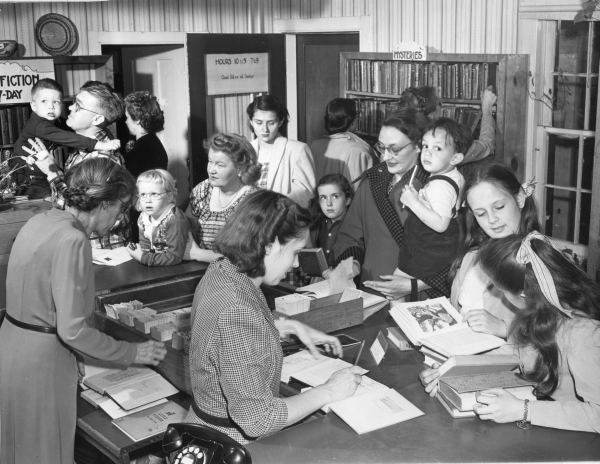
Circulation Desk at 934 West Broad Street in 1951
1950 - 1959
1950 - The library hosts an Author's Night program featuring local writers. The library moves again, this time to larger - but still crowded - quarters at 934 West Broad Street.
1954 - The City Council reaffirms the establishment of the independent Falls Church Public Library with a seven-member Board of Trustees.
1955 - After two local Black leaders, the Reverend Wallace Earl Costner and Dr. Edwin Bancroft Henderson, meet with the librarian to discuss the library's service to the Black community, the Board votes unanimously to offer Black children "the same services now being given other city school children." The library moves to a new rental space at 201 East Broad Street.
1956 - Library Board Chairman John Bold addresses a public meeting on a bond issue proposal to finance the construction of a dedicated library building, asserting that "the library is your library... It belongs to you, to all of you... regardless of class, or creed, or color."
1957 - Ground is broken on land donated from the estate of Mary Riley Styles for the construction of a new library building.
1958 - On July 4, the new building at 120 North Virginia Avenue opens its doors to the public. After nearly sixty years of moving between rental properties, the library now has a home of its own.
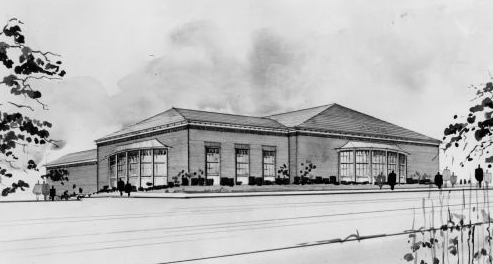
Architectural drawing of the new library c. 1965
1960 - 1969
1960 – Supreme Court Justice William O. Douglas is guest speaker at a "Sunday Evening at the Library" lecture program.
1960 – Richard K. Burns becomes Library Director. During his tenure, the library will publish a book on the history of Falls Church, introduce record albums and framed art reproductions into the collection, and set an ambitious goal to increase the library book collection size from 45,000 to 100,000 volumes. Burns will go on to serve on the White House Commission on Libraries.
1965 – During National Library Week in April, the library hosts its inaugural oral history program. The recording captures participants' reminiscences of life in Falls Church.
1968-1969 – The library is renovated, adding 5,000 square feet to its space. The children's collection moves from the lower level to an upper level room with a large bay window.
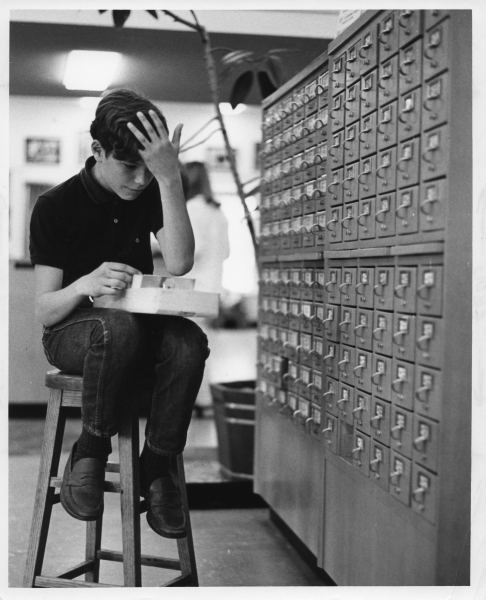
Young boy looking through the library's card catalog c. 1970
1970 - 1979
1970 – The library introduces a selection of contemporary paperbacks into the collection. While some of the titles stir controversy, the books prove very popular with the public.
1971 – "Patrons appear delighted" with the successful first trial of a reciprocal borrowing agreement with nearby county library systems. Deane Dierksen begins work as a new part-time reference librarian; she will become Library Director in 1977, and will serve in that position for more than two decades.
1972 – The library aims to build "a notable mystery collection" by adding "above-average mysteries" to the paperback collection.
1973 – With the assistance of volunteers, the library begins offering service to homebound community members.
1977 – The "Falls Church Public Library" is renamed in honor of Mary Riley Styles. At the renaming ceremony, Elizabeth Styles says, “I must admit that this is the happiest day of my life standing here in this building that I wish my dear mother could also stand in now. I think she’d be the happiest person in this world to know that everything she had dreamed of and wanted had come into being.”
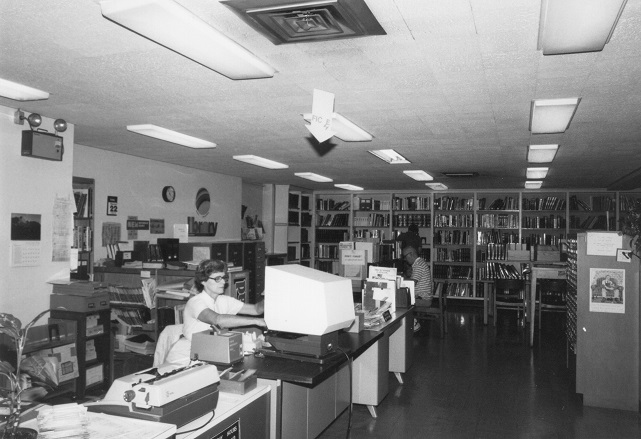
Librarian at the Reference Desk in 1984
1980 - 1989
1980 – The library accepts the collection of the Falls Church Historical Commission, "to be managed and operated for the benefit of the public." The library uses $2,000 in federal aid to purchase large print books.
1981 – Some 140 children participate in a revived summer reading program; they read a grand total of 3,000 books.
1982 – The Library Board of Trustees establishes a new "Policy for Selection of Library Materials" that cites the Library Bill of Rights and emphasizes "the freedom to read."
1983 – "The video business is booming!": When 101 videocassettes are added to the library collection, they circulate 456 times in the first month. The library will also begin offering CDs during this decade.
1984 - 1985 – After the library catalog is converted to microfiche, the card catalogs are moved. The staff works hard to help patrons learn to use the new system.
1988 – In a report on services to minorities, the library recommends the acquisition of more materials for Hispanic and Asian community members.
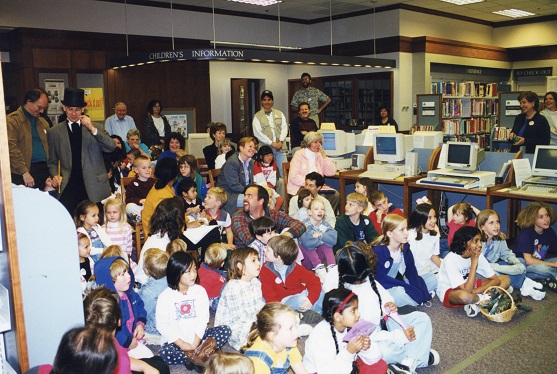
Library Centennial Celebration, 1999
1990 - 1999
1990 – The library introduces its new online catalog, dubbed "LYNX" after the library holds a "Name the Cat" contest. A new automated circulation system also goes live.
1992 - 1993 – While the permanent building undergoes extensive expansion and renovation, including changes to meet the standards of the recent Americans with Disabilities Act, the library serves the public from a temporary location in the vacant drugstore space at 134 West Broad Street. The renovated building opens with a dedication ceremony honoring library volunteers. An art installation of colorful ceramic tiles created by local schoolchildren is unveiled.
1997 – Patrons enjoy using the latest library innovation: a self-checkout station. The library adds the subject heading "Oprah Winfrey Book Club Selections" to the catalog to help patrons find these popular titles.
1999 – The library celebrates its 100th anniversary! Festivities include a reception in the children's room and a barbershop quartet performance. A "Food for Fines Week" is offered when patrons are able to donate food items in lieu of paying overdue fines. The library sets up new computer stations and offers free internet service to the public.
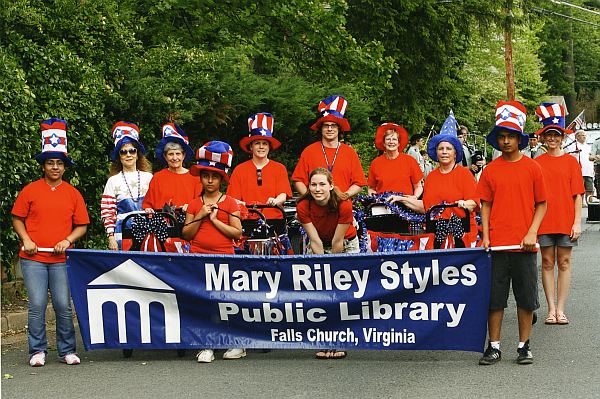
Library staff march in the City's Memorial Day Parade 2009
2000 - 2009
2001 – After the September 11th attacks, the library orders books on "topics of immediate interest."
2002 – The Local History Room marks its 50th anniversary with a celebratory program. Later in the year, Linda Sue Park appears at the library for an author talk and book signing. The Korean Broadcasting System is on hand to interview her about A Single Shard, her Newbery Award-winning book.
2003 – The recently established Mary Riley Styles Public Library Foundation presents the library with a check for $3,500. During National Library Week, one of the staff librarians is chosen to have brunch with First Lady (and former librarian) Laura Bush.
2005 – Patrons enjoy two new conveniences: Wi-Fi inside the building and a new drive-up book drop outside.
2006 – The library begins offering access to Heritage Quest, an online database for tracing family history and American culture, as well as downloadable electronic audiobooks.
2007 – Pride and Prejudice wins "Favorite Book" in a library-conducted poll. In July, Amazon recognizes Falls Church as the "Harry-est Town in America," based on the number of pre-orders they receive for Harry Potter and the Deathly Hallows. The library uses the $5,000 prize money to purchase children's and young adult books.
2009 – The library makes Book Club to Go kits available for checkout.
Falls Church History Room in 2024
2010 - present
2010 – The library helps celebrate the Tinner Hill Blues Festival by hosting a reading of blues poetry.
2011 – A new eBooks collection goes live, to be followed by eAudiobooks and digital magazines in 2013.
2015 – The MRSPL Foundation receives a check for $250,000 from the estate of Arlington resident Mary Prior Hassan, who bequeathed the funds for the "general mission of the library."
2016 – City residents approve an $8.7 million bond referendum for what will be the third renovation and expansion of the library building.
2020 – While construction begins on the new 6,600 square foot expansion, the library opens a temporary facility at 601 South Oak Street – only to close to the public after one week due to COVID-19. To provide service during the pandemic, the library introduces curbside pickup and virtual programming.
2021 – A ribbon-cutting ceremony is held for the official opening of the renovated and expanded library building, which includes a more accessible Falls Church History Room.
2024 – The library marks its 125th anniversary with a year of celebration and an expression of thanks to the community for 125 years of support.




























